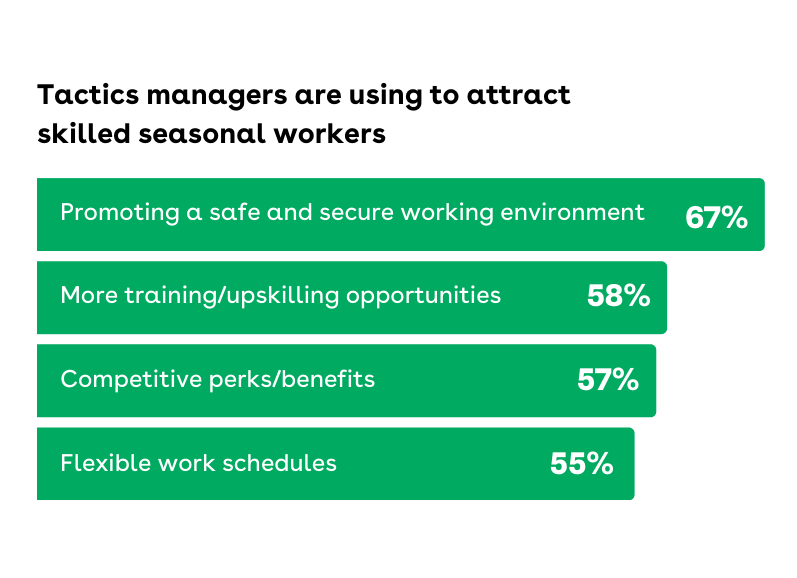We talked to 300 frontline managers about seasonal hiring. Here’s what we learned.
It’s that time again. Peak shopping and travel days are fast approaching, and frontline organizations are once again looking to meet that increased demand with a fortified workforce, trained and ready to deliver the memorable experiences that customers and guests are expecting. But will they be ready?

Last year we talked to the frontline about what job seekers were looking for as they weighed the myriad options of seasonal work. This year, we’re talking to frontline managers.
We talked to 300 U.S. frontline managers in retail, hospitality and foodservice about the urgent need for skilled seasonal workers and what they’re doing to attract them, the overburdening of managers around peak hiring and onboarding periods and a possible solution to seasonal understaffing.
Here’s what we learned.
Seasonal hiring is on the rise…
Nearly half of managers polled said they are hiring more new workers this year, either because they simply need more people physically on the floor or because their current staff doesn’t have the skill sets or expertise to perform the specific jobs needed. Furthermore, a similar segment of managers polled believe that the demand for seasonal workers in retail and hospitality will increase in the next year:
- 48% of managers said they are hiring more new workers this year
- 47% of managers believe the demand for seasonal workers will increase in the next year
…But the quality of applicants is worse (despite more and more tactics to attract skilled workers)
More than half of managers said it’s more difficult to find workers this year, and almost 60% of managers said the quality of seasonal job applicants is worse, in terms of skill set, professionalism and job-related experience.
This may be in part due to political and economic shifts; over half of managers polled believe these situations have impacted their ability to find seasonal workers. But another reason for this may be that over half of managers said they’ve had to revise their job descriptions, dropping education, skill requirements or location-based requirements to encourage more people to apply.

What other tactics are managers using to try and attract more skilled applicants? Promoting safe and secure work environments topped the list (no surprise, considering 40% of retail and grocery associates are scared to go to work). But other commonly-used offerings were increased opportunities for training and upskilling, more competitive perks and benefits and more flexible work schedules.

Furthermore, many managers are seeing applicants come from new and varied situations and communities , with an increase in retired workers looking to rejoin the workforce and over half of managers saying they’ve opened up hiring to “second chance talent,” workers with a non-violent criminal record:
- 52% of managers said it’s become more difficult to find seasonal workers this year and 59% of managers said the quality of applicants has become worse this year
- 57% of managers said they had to revise their job descriptions to have less requirements to encourage more applicants
- 52% of managers believe that political and economic situations (like inflation) are impacting their ability to find seasonal workers
- 56% of managers have seen an increase in retired worker applicants
- 53% of managers are hiring applicants with non-violent criminal records
The burden of recruiting, hiring and training seasonal staff is (still) on managers…
The role that managers play in keeping their locations staffed cannot be overstated. From anticipating new roles and skill gaps to recruiting, interviewing, hiring and training applicants, the responsibilities that managers play in the process are taxing at the best of times. But during peak seasonal hiring periods, many managers find that the majority of their time is spent finding seasonal staff, leaving no time for everything else they need to do (like enabling current staff to prepare for peak periods). As a result, 60% of managers said this time of year they spend the majority of their time recruiting, hiring and onboarding seasonal workers.


…Leading to increased burnout and even manager turnover, perpetuating the problem even further
When asked what keeps them up at night during peak work seasons, the overwhelming response from frontline managers was “understaffing,” with inventory issues, safety concerns and even theft ranked considerably lower. In fact, over 60% of managers polled said they feel more burned out leading into peak seasons. Considering 49% of managers already feel burned out on a daily basis, this is a worrisome stat.
And with nearly half of managers having considered quitting in the past two months, there’s a serious risk of even more staffing issues ahead. After all, what happens if organizations lose the managers responsible for nearly all the tasks related to sourcing, hiring and onboarding staff?

- 62% of managers feel more burned out leading up to peak work seasons
- 46% of managers said seasonal hiring increases their burnout
- 47% of managers have considered quitting in the past two months
- Understaffing was ranked as the top challenge keeping frontline managers up at night during peak work seasons
All of which is an urgent problem, because understaffing is expected to cause a lot of business impacts
The risk of a perpetual cycle of understaffing and burnout can result in major impacts on the business, according to frontline managers. The ability to deliver a memorable and consistent guest or customer experience, adhere to compliance regulations, adhere to safety and security protocols, and control customer issues like theft and violence are all at risk.
According to managers, seasonal staffing challenges impact frontlines’ ability to:
- Deliver a consistent guest or customer experience (62%)
- Deliver a memorable guest or customer experience (58%)
- Control customer issues like theft and violence (52%)
- Adhere to safety and security protocols (50%)
- Adhere to compliance regulations (46%)

What’s the solution? Optimized training and foundational worker needs.
The need for optimized training is at the core of many of these staffing challenges. Managers need new hires onboarding and on the floor faster—but also there’s a need for managers to make good on the promised training and upskilling opportunities they’re offering to prospective staff.
When asked about the top focuses when training new hires this year, managers ranked accordingly:
- Upskilling/reskilling (31%)
- Customer de-escalation (26%)
- Safety, violence and crime (20%)
- Emerging technology (like AI) (13%)
- No formal training (just on-the-job learning) (9%)

But there are several hurdles at play—and not just the fact that onboarding and training are currently the sole responsibility of managers.
When asked about the barriers impacting training new hires, managers responded:
- Disengaged employees (25%)
- Outdated or ineffective training methods (20%)
- No time to prioritize training (18%)
- Budget constraints (17%)
- No formal training (just on-the-job learning) (11%)
- Language/cultural barriers (9%)

Disengaged employees who aren’t interested in training ranked at the top of the list, followed closely by outdated or ineffective training methods. Those two definitely go hand-in-hand. When workers aren’t given training in an approach, format and timing that makes sense for the frontline world of work, it’s no surprise that they’re not interested in investing their time and energy into completing it.
Furthermore, when asked what would help streamline the seasonal hiring and training process, managers responded:
- More support from HQ (65%)
- More empowered/engaged workforce (63%)
- Stronger employee/manager community to share ideas (62%)
- Wellbeing/mental health support for employees (62%)
- A digital learning solution that automatically flags knowledge gaps (61%)
- More consolidated admin/technology to streamline training (60%)
- More direct communication between HQ and employees (57%)
- Faster onboarding (56%)
- More employee referrals (53%)


There’s a theme here. Managers put “more support from headquarters” at the top of the list, followed closely by “a more engaged and empowered workforce” and “a stronger employee-manager community”. In other words, they are seeing the value of addressing more foundational worker needs—going beyond the basics of smaller perks toward fostering more long-term connections that will engage and empower employees to stay loyal and engaged for the long term.
Pairing these foundational offerings with other tactics, like digital solutions and consolidated admin that will help to lessen the managerial load, and frontline organizations are well on their way to streamlining seasonal hiring and training.